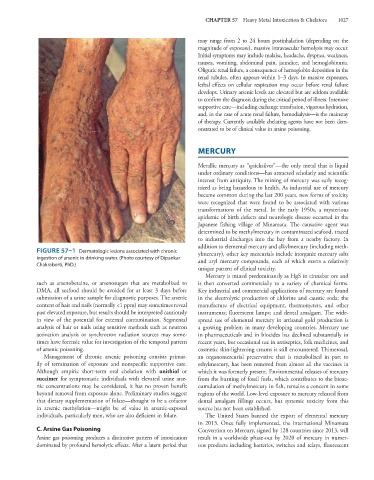Page 1041 - Basic _ Clinical Pharmacology ( PDFDrive )
P. 1041
CHAPTER 57 Heavy Metal Intoxication & Chelators 1027
may range from 2 to 24 hours postinhalation (depending on the
magnitude of exposure), massive intravascular hemolysis may occur.
Initial symptoms may include malaise, headache, dyspnea, weakness,
nausea, vomiting, abdominal pain, jaundice, and hemoglobinuria.
Oliguric renal failure, a consequence of hemoglobin deposition in the
renal tubules, often appears within 1–3 days. In massive exposures,
lethal effects on cellular respiration may occur before renal failure
develops. Urinary arsenic levels are elevated but are seldom available
to confirm the diagnosis during the critical period of illness. Intensive
supportive care—including exchange transfusion, vigorous hydration,
and, in the case of acute renal failure, hemodialysis—is the mainstay
of therapy. Currently available chelating agents have not been dem-
onstrated to be of clinical value in arsine poisoning.
MERCURY
Metallic mercury as “quicksilver”—the only metal that is liquid
under ordinary conditions—has attracted scholarly and scientific
interest from antiquity. The mining of mercury was early recog-
nized as being hazardous to health. As industrial use of mercury
became common during the last 200 years, new forms of toxicity
were recognized that were found to be associated with various
transformations of the metal. In the early 1950s, a mysterious
epidemic of birth defects and neurologic disease occurred in the
Japanese fishing village of Minamata. The causative agent was
determined to be methylmercury in contaminated seafood, traced
to industrial discharges into the bay from a nearby factory. In
addition to elemental mercury and alkylmercury (including meth-
FIGURE 57–1 Dermatologic lesions associated with chronic ylmercury), other key mercurials include inorganic mercury salts
ingestion of arsenic in drinking water. (Photo courtesy of Dipankar and aryl mercury compounds, each of which exerts a relatively
Chakraborti, PhD.)
unique pattern of clinical toxicity.
Mercury is mined predominantly as HgS in cinnabar ore and
such as arsenobetaine, or arsenosugars that are metabolized to is then converted commercially to a variety of chemical forms.
DMA, all seafood should be avoided for at least 3 days before Key industrial and commercial applications of mercury are found
submission of a urine sample for diagnostic purposes. The arsenic in the electrolytic production of chlorine and caustic soda; the
content of hair and nails (normally <1 ppm) may sometimes reveal manufacture of electrical equipment, thermometers, and other
past elevated exposure, but results should be interpreted cautiously instruments; fluorescent lamps; and dental amalgam. The wide-
in view of the potential for external contamination. Segmental spread use of elemental mercury in artisanal gold production is
analysis of hair or nails using sensitive methods such as neutron a growing problem in many developing countries. Mercury use
activation analysis or synchrotron radiation sources may some- in pharmaceuticals and in biocides has declined substantially in
times have forensic value for investigation of the temporal pattern recent years, but occasional use in antiseptics, folk medicines, and
of arsenic poisoning. cosmetic skin-lightening creams is still encountered. Thimerosal,
Management of chronic arsenic poisoning consists primar- an organomercurial preservative that is metabolized in part to
ily of termination of exposure and nonspecific supportive care. ethylmercury, has been removed from almost all the vaccines in
Although empiric short-term oral chelation with unithiol or which it was formerly present. Environmental releases of mercury
succimer for symptomatic individuals with elevated urine arse- from the burning of fossil fuels, which contributes to the bioac-
nic concentrations may be considered, it has no proven benefit cumulation of methylmercury in fish, remains a concern in some
beyond removal from exposure alone. Preliminary studies suggest regions of the world. Low-level exposure to mercury released from
that dietary supplementation of folate—thought to be a cofactor dental amalgam fillings occurs, but systemic toxicity from this
in arsenic methylation—might be of value in arsenic-exposed source has not been established.
individuals, particularly men, who are also deficient in folate. The United States banned the export of elemental mercury
in 2013. Once fully implemented, the international Minamata
C. Arsine Gas Poisoning Convention on Mercury, signed by 128 countries since 2013, will
Arsine gas poisoning produces a distinctive pattern of intoxication result in a worldwide phase-out by 2020 of mercury in numer-
dominated by profound hemolytic effects. After a latent period that ous products including batteries, switches and relays, fluorescent

